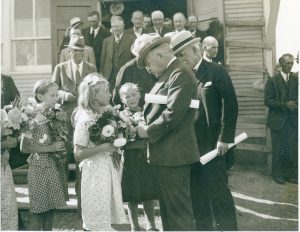Mennonite Brethren in North America
Freedom, prosperity, growth
Mennonites came to North America as part of several migrations from Russia.
About 400 Mennonite Brethren were part of the migration of some 10,000 Mennonites to the USA in the 1870s. Some eventually came to Canada to conduct evangelistic services in southern Manitoba, among Mennonites who had settled there, with the first MB church formed in the Winkler area in 1888. (The first Mennonite immigrants in Canada were often called Kanadier.)
Another huge influx of some ·21,000 Mennonites came to North America in the 1920s and 30s, with some 4,000 of them Mennonite Brethren. (These immigrants were called Russlaender.)By 1934, there were more than 40 MB congregations in Canada. More immigrants came after World War II. By 1945, there were 62 MB congregations (9,000 members) in Canada.
Challenges and issues MBs faced in Canada:
Struggles to adjust.
The Russlaender arrivals, often traumatized by their experiences, struggled to adjust to North American society. There were some tensions between the Russlaender and Kanadier Mennonites, and ittook time for the Russlaender to be fully integrated into MB conference leadership structures which were centred in the U.S.
Concern for their young people.
Facing the question of how to transfer religious values to the next generation and afraid of the impact of an unknown culture, MB Ieaders started dozens of Bible schools. (No denomination in Canada operated more Bible schools during the first half of the 20th century or sent more of its young people to Bible school than the MBs.)
Language transition.
The.young people led the way in the transition from German to English during the 1950s and 60s.
Impact of evangelicalism and fundamentalism.
MBs had natural compatibility with evangelicalism (biblicism, evangelism, conversion) and began to connect with other evangelical Protestants in North America. Many also accepted the eschatological scheme of dispensational premillenialism. The influence of evangelicalism precipitated considerable debate concerning MB “identity.” From the perspective of the larger evangelical world, no Mennonite denomination has contributed more resources and personnel than the MBs.
A professionalized ministry.
The move from multiple unpaid lay pastors to paid professionals that began in the 1950s was controversial.
Economic opportunities.
Openness to education, and a willingness to live in urban centres, allowed many Mennonites to realize “the American dream.” The MBs were one of the most rapidly acculturated Mennonite denominations in Canada.
Name change.
As MBs became more Canadianized, a debate concerning the name of the denomination emerged. Was “Mennonite” a religious or an ethnic term? A hindrance or an integral part of the denomination’sheritage and identity? Aside from the matter of identity and name, it is worth noting that the historic German-Russian congregations have not moved beyond ethnicity; they have taken on a Canadian ethnicity.
Notes by Bruce Guenther, Pastors Credentialing Orientation 2005
